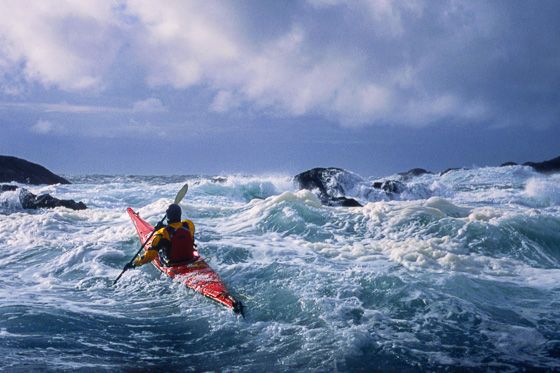- English
- Español
- Português
- русский
- Français
- 日本語
- Deutsch
- tiếng Việt
- Italiano
- Nederlands
- ภาษาไทย
- Polski
- 한국어
- Svenska
- magyar
- Malay
- বাংলা ভাষার
- Dansk
- Suomi
- हिन्दी
- Pilipino
- Türkçe
- Gaeilge
- العربية
- Indonesia
- Norsk
- تمل
- český
- ελληνικά
- український
- Javanese
- فارسی
- தமிழ்
- తెలుగు
- नेपाली
- Burmese
- български
- ລາວ
- Latine
- Қазақша
- Euskal
- Azərbaycan
- Slovenský jazyk
- Македонски
- Lietuvos
- Eesti Keel
- Română
- Slovenski
- मराठी
- Srpski језик
How to do Eskimo roll?
2023-04-03
Eskimo roll is the best and safest technique to recover yourself if you ever happen to capsize. It is fast and you don't have to hop out of your kayak into cold water and figure out how to empty it and get back in.
Eskimo roll technique is based on the same principles that are taught in the chapter Braces and rolling basics. Therefore you should read it first throughout. From there, you will find tips on safety matters and practicing.
There are tens of different kinds of ways to perform an Eskimo roll. Fortunately, you only need to master one or two. For an open-water paddler, one is often enough. The style we are about to learn is probably the most commonly taught and one of the easiest.
Remember that learning to roll can be quite easy but doing it in real-life situations is different. So keep practicing regularly.
When practicing the first time, it is easier to take the starting position for the roll before capsizing. But also in real life, if you are fast enough to get to the starting position before you fall under the water, it makes things a lot easier. This way you don't have to spend time and oxygen trying to figure out how to move the paddle to the correct position under the water.
Grip the paddle normally. Rotate your upper body and place the paddle on the kayak's left side. It is essential to check that the right blade is powered face up so that the edge closer to the kayak is elevated. This means that after you have capsized and started to do the sweep, the blade will create a lifting force instead of diving under the surface.
Lean forward towards the deck and keep your head down. Keep your right arm almost straight and place the paddle as forward and down as possible. Sit firmly, meaning that your knees touch the deck and your heels are against the bottom. This will prevent you from falling out of the kayak during the roll.
Lean slightly to the left and you will capsize. Now that you are upside down under the water, you need to get a hold of the situation. Try to orientate and stay calm, since panicking is usually the fundamental reason behind failed Eskimo rolls. One thing that can help is to try to develop a certain pattern you always follow. It's like convincing yourself that everything is in control.
You probably already are roughly in the right starting position. Learn more forward and push your nose towards the deck. This way you will be already near the surface when you start the roll. Push your paddle just a little bit more forward and away from the kayak and check that your both hands are above the surface.
Keep your hands in a fixed posture and begin the stroke by starting to straighten your upper body. Make sure that the blade will stay at a right "climbing" angle while you do the sweep. This will create a lifting force and you will soon be floating sideways right under the surface.
Keep doing the sweep by straightening your body. Your first task is to get the kayak rightened. Keep your upper body and head close to the surface but do not lift them out of the water. Straighten the kayak by doing the hip flick; twist your waist and push the kayak's deck with your right knee.
Now that the kayak is almost straightened, it is time to also get your upper body on top of the kayak. Continue the stroke and lean towards the rear deck. Hopefully, you have done the hip flick fast enough and the rotating movement of the kayak will help you to succeed.
TIP:
–The cockpit coaming in some sea kayak models can be quite high so leaning back becomes quite difficult. In this case, you can let your bottom raise slightly up from the seat, but beware that you don't slip out of the kayak.
At the end of the roll, it may seem difficult to continue the stroke towards the stern. Push the blade down and try to slide the kayak under your upper body. If the paddle starts to sink too early, start to push the blade towards the bow. But remember to keep the blade at a rising angle. Finally, recover yourself and try to regain your balance.
And what to do if it fails? When you feel that your rolling attempt is not going to succeed, give up and try to get your head above the surface. This way you can at least get some air so that you will have more time to perform another try. And try to get yourself to the starting position before you start to fall again.
If you feel that your attempts are not even close, you can try to call help by raising your arms above the surface and waving them. This way, if one of your friends is fast enough, you can use a technique called assisted Eskimo rescue. It means that your friend brings the bow of his kayak next to you and you pull yourself up.
If the air starts running out, your only option is to pull off your spray skirt and hop out.
TIP:
Eskimo roll technique is based on the same principles that are taught in the chapter Braces and rolling basics. Therefore you should read it first throughout. From there, you will find tips on safety matters and practicing.
There are tens of different kinds of ways to perform an Eskimo roll. Fortunately, you only need to master one or two. For an open-water paddler, one is often enough. The style we are about to learn is probably the most commonly taught and one of the easiest.
Remember that learning to roll can be quite easy but doing it in real-life situations is different. So keep practicing regularly.
When practicing the first time, it is easier to take the starting position for the roll before capsizing. But also in real life, if you are fast enough to get to the starting position before you fall under the water, it makes things a lot easier. This way you don't have to spend time and oxygen trying to figure out how to move the paddle to the correct position under the water.
Grip the paddle normally. Rotate your upper body and place the paddle on the kayak's left side. It is essential to check that the right blade is powered face up so that the edge closer to the kayak is elevated. This means that after you have capsized and started to do the sweep, the blade will create a lifting force instead of diving under the surface.
Lean forward towards the deck and keep your head down. Keep your right arm almost straight and place the paddle as forward and down as possible. Sit firmly, meaning that your knees touch the deck and your heels are against the bottom. This will prevent you from falling out of the kayak during the roll.
Lean slightly to the left and you will capsize. Now that you are upside down under the water, you need to get a hold of the situation. Try to orientate and stay calm, since panicking is usually the fundamental reason behind failed Eskimo rolls. One thing that can help is to try to develop a certain pattern you always follow. It's like convincing yourself that everything is in control.
You probably already are roughly in the right starting position. Learn more forward and push your nose towards the deck. This way you will be already near the surface when you start the roll. Push your paddle just a little bit more forward and away from the kayak and check that your both hands are above the surface.
Check also that the blade in front of you has the edge further from the kayak elevated. You can do this by slapping it to the surface or by simply grabbing the blade with your hand and feeling how it is oriented. You will have plenty of time for at least two good rolling attempts so don't rush with the setup.

Keep your hands in a fixed posture and begin the stroke by starting to straighten your upper body. Make sure that the blade will stay at a right "climbing" angle while you do the sweep. This will create a lifting force and you will soon be floating sideways right under the surface.
Keep doing the sweep by straightening your body. Your first task is to get the kayak rightened. Keep your upper body and head close to the surface but do not lift them out of the water. Straighten the kayak by doing the hip flick; twist your waist and push the kayak's deck with your right knee.
Now that the kayak is almost straightened, it is time to also get your upper body on top of the kayak. Continue the stroke and lean towards the rear deck. Hopefully, you have done the hip flick fast enough and the rotating movement of the kayak will help you to succeed.
TIP:
–The cockpit coaming in some sea kayak models can be quite high so leaning back becomes quite difficult. In this case, you can let your bottom raise slightly up from the seat, but beware that you don't slip out of the kayak.
At the end of the roll, it may seem difficult to continue the stroke towards the stern. Push the blade down and try to slide the kayak under your upper body. If the paddle starts to sink too early, start to push the blade towards the bow. But remember to keep the blade at a rising angle. Finally, recover yourself and try to regain your balance.
And what to do if it fails? When you feel that your rolling attempt is not going to succeed, give up and try to get your head above the surface. This way you can at least get some air so that you will have more time to perform another try. And try to get yourself to the starting position before you start to fall again.
If you feel that your attempts are not even close, you can try to call help by raising your arms above the surface and waving them. This way, if one of your friends is fast enough, you can use a technique called assisted Eskimo rescue. It means that your friend brings the bow of his kayak next to you and you pull yourself up.
If the air starts running out, your only option is to pull off your spray skirt and hop out.
TIP:
– Tracking the reason for failure can be difficult. Focus on keeping the blade at the right angle, sit firmly, and don't lift your head above the surface too early.
Previous:Common fishing line knotting methods



